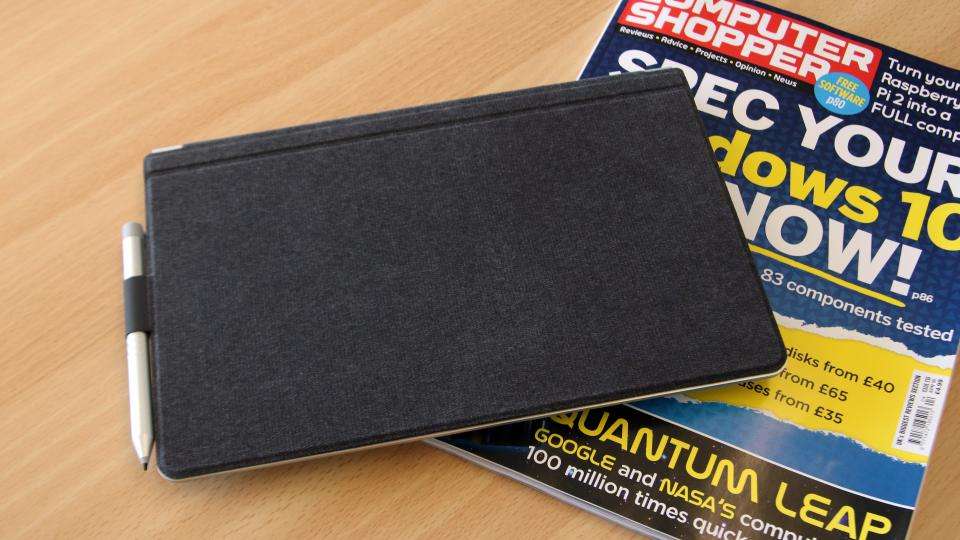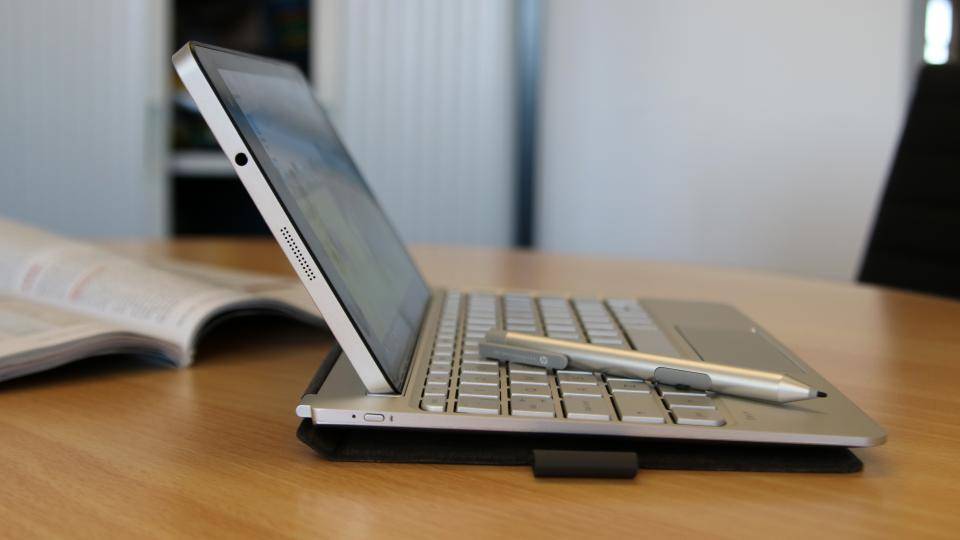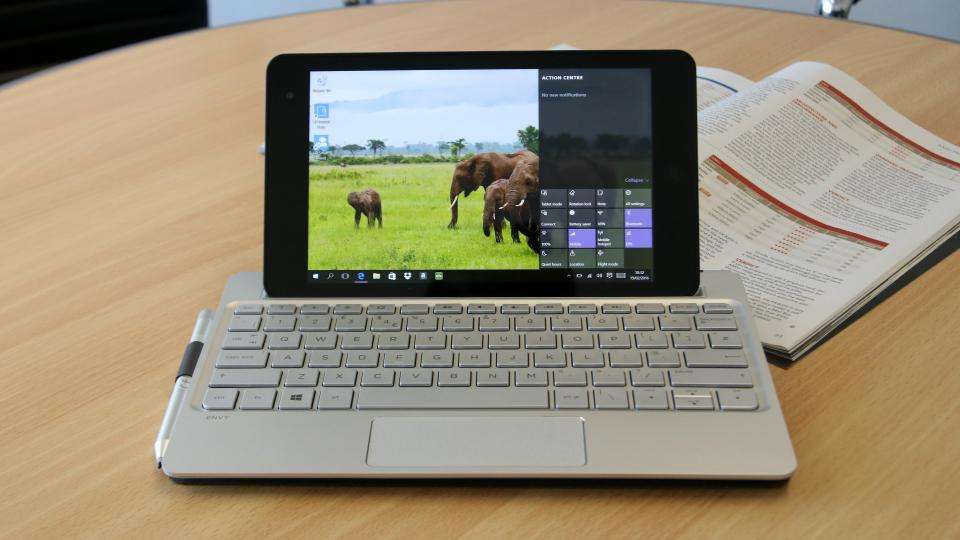There’s something quite comical about the HP Envy 8 Note. It’s first and foremost an 8in tablet running Windows 10, but then there’s the 10in keyboard stand that’s quite a bit larger than the actual tablet. This makes the whole assembly look rather imbalanced when paired together, and it's quite possibly one of the strangest tablet-laptop hybrids I've seen in some time.
It certainly doesn't have the elegance of Microsoft's Surface Pro 4 or Surface 3 , for example, and the tablet's sharp, rough edges aren't particularly comfortable to hold for long periods of time either. It measures 7.7mm in thickness, which isn’t particularly svelte, and weighs 368g, so it's not particularly light for its size.
A stylus is included and the thickness of the tablet becomes noticeable when you prod at the screen or jot down notes with your other hand. Its plastic construction doesn’t particularly impress and the bezels around the 8in screen are also rather thick, detracting from any kind of premium status . The back of the tablet is a little more exciting, with a white backing accented by a glossy black strip along its top and an embossed ‘8’ logo’ to the side.
Along the edges are the power button, volume rocker, a Micro USB charging port and a 3.5mm headset jack. There’s also a Micro SIM slot to take advantage of its 4G-capable modem, but 802.11ac Wi-Fi and Bluetooth 4.0 networking are onboard as well.
Annoyingly, the microSD slot is tucked away in the same slot as the Micro SIM, which you need to use a pin to access. This makes hot-swapping microSD cards inconvenient, so it’s really designed for you to just leave the same microSD card in all the time. There's no display output, so connecting the tablet up to a separate screen isn't an option.
There's a 5 megapixel camera on the back that produces noisy, disappointing images with poor colours. The front 2 megapixel does a serviceable enough job for videoconferencing, but when there's only a single speaker that isn't particularly loud, you'll need to use headphones to hear the other person speaking to you.
Performance
In terms of specifications, the Envy 8 Note is a rather middling affair. Inside is a quad-core 1.44GHz Intel Atom x5-Z8300 processor with 2GB of RAM and 32GB of eMMC storage, but you can expand the storage with a microSD card up to 64GB in size.
The performance was as lacklustre as I expected, managing a score of just 6 in our application benchmarks. Even just navigating around Windows 10 proved a sluggish and frustrating experience, with applications stuttering or taking a long time to open. As a comparison, I ran the same benchmark on the Linx 7 running Windows 10 and managed a score of 3, which is worse but then this is a tablet that costs just £55. Even basic tasks like web browsing felt tedious on the Envy 8 Note, with it taking several seconds for more image-heavy websites to become responsive. A Peacekeeper score of just 544 is a testament to this.
You get Microsoft’s Office Mobile suite of Word, Excel, PowerPoint and OneNote included, but there’s a considerable amount of HP software pre-installed as well as some other apps like Evernote. It means you end up with three different note-taking applications pre-installed when you include HP’s Instant Notes software, which is overkill. Considering you only have about 15GB of space available to you after the Windows 10 operating system, you might want to uninstall some applications to free up space.
Light gaming is possible, but not much beyond that. Expect to only be playing simpler games from the Windows Store. In the GFXBench DX's Manhattan onscreen test, it only managed a score of 452 (7.3fps) and 432 (8.6fps) in the offscreen test. That said, we were able to play a relatively smooth round of Beach Buggy Racing, but don't expect to play anything more serious.
The Envy 8 Note only managed 4 hours 35 minutes in our video playback test, which is disappointing. You'll be able to stretch this out with lighter usage, but it's still not going to be enough to get you through a day's work if you insist on using it as your main device.
Display
The display, too, is disappointing. Its resolution of 1,920x1,200 is reasonable enough for a screen of this size but the backlighting is laughably poor. It’s so uneven that there’s essentially a bright frame of light around the edge and corners.
Its brightness levels were actually very good at 351.7cd/m2, but this was when the tablet was on mains power. On battery, it’s limited to 280cd/m2, which isn’t so ideal for outdoor use. Black levels were pretty abysmal at 0.43cd/m2, leading to a contrast ratio of just 804:1, placing the tablet firmly below average when it comes to screen quality. Its accuracy of 67% of the sRGB colour gamut is also disappointing, so colours are completely lacking in richness and depth, and the tablet's viewing angles are rather acute, too.
Keyboard and Touchpad
Surprisingly, the better materials seem to have been saved for the keyboard folio attachment. This is made from aluminium and feels well-constructed, especially when you put it next to the tablet. It’s got some good weight to it and the wool cover has a nice soft-touch feel. The keyboard alone weighs 534g. There’s also a slot on the back of the keyboard where the tablet can slide in, keeping both devices together.

Where other hybrid 2-in-1 devices often clamp into their keyboard bases, there’s no such mechanism here. In fact, there’s simply a slightly angled groove where the tablet slots in. That means there’s no angle adjustment and you definitely can’t pick up the entire device by the screen.
The keyboard pairs with the tablet over Bluetooth, and has a battery that charges over Micro USB separately. HP rates the battery at up to 24 days or 16 hours of use, and certainly over a week of testing, I never had to charge it.
The over-sized keyboard is meant to allow for a more generous typing area, but even then the keyboard still feels cramped. The keys are all packed tightly together, making typing uncomfortable and more of a struggle than I would like. I’ve managed to type this review up on the device while wrestling with typos and hitting multiple keys at the same time, but it'd definitely not something I would want to use as my main method of working.
It doens't help that the front edge of the aluminium frame is sharp, which digs into your palms as you type. The small touchpad is equally frustrating. It’s a decent width but it’s about half the vertical height you’re probably used to on a laptop touchpad. It means scrolling through documents and web pages require lots of finger swipes, but even these feel laggy and unresponsive at times.
I tried to adjust the settings to find a better compromise, but I had no such luck. Two-finger scrolling did at least work correctly most of the time, but I couldn’t find an option to reverse the scrolling direction. Three-finger gestures didn’t work. The surface of the touchpad also has a lot of resistance.

The included stylus isn’t a patch on the Surface Pen that comes with the Microsoft Surface Pro 4 or Microsoft Surface Book . There are secondary buttons, one of which opens up a radial selector on the screen with shortcuts to note take, the calculator and other useful functions such as copy and paste. There’s only a loop of fabric on the edge of the keyboard for you to slide the stylus in and there’s a decent chance you’re going to end up misplacing it.
Conclusion
For what you’re getting, the HP Envy 8 Note is a lot of money for a mediocre tablet and an even more disappointing hybrid. The keyboard folio doesn’t add much, aside from a degree of frustration and some funny looks, and performance-wise, the tablet just isn't fast enough for you to justify trying to convert it into a productivity laptop, making its purpose rather questionable. Taking notes on it with the stylus works well enough but you're paying far too much for even that basic privilege.
A more conventional hybrid like the Toshiba Satellite Click Mini has plenty of compromises, too, and there's no stylus, but at least you'll save yourself some money, but at this kind of price, the £419 Surface 3 is just streets ahead of both tablets, giving you a lot more for your money without driving you to frustration.
|
Hardware |
|
Processor |
Quad-core 1.44GHz Intel Atom X5-Z8300 |
|
RAM |
2GB |
|
Screen size |
8in |
|
Screen resolution |
1,920x1,200 |
|
Screen type |
IPS |
|
Front camera |
2 megapixel |
|
Rear camera |
5 megapixel |
|
Flash |
No |
|
GPS |
Yes |
|
Compass |
No |
|
Storage (free) |
32GB (15GB) |
|
Memory card slot (supplied) |
microSD (None) |
|
Wi-Fi |
802.11ac Wi-Fi |
|
Bluetooth |
4.0 |
|
NFC |
No |
|
Wireless data |
4G |
|
Dimensions |
126.6x218x7.7mm |
|
Weight |
368g |
|
Features |
|
Operating system |
Windows 10 Home |
|
Battery size |
Not disclosed |
|
Buying information |
|
Warranty |
One year RTB |
|
Price |
£359 |
|
Supplier |
store.hp.com/UKStore |
|
Details |
store.hp.com/UKStore |
|
Part code |
HP Envy 8 Note 5001na |

